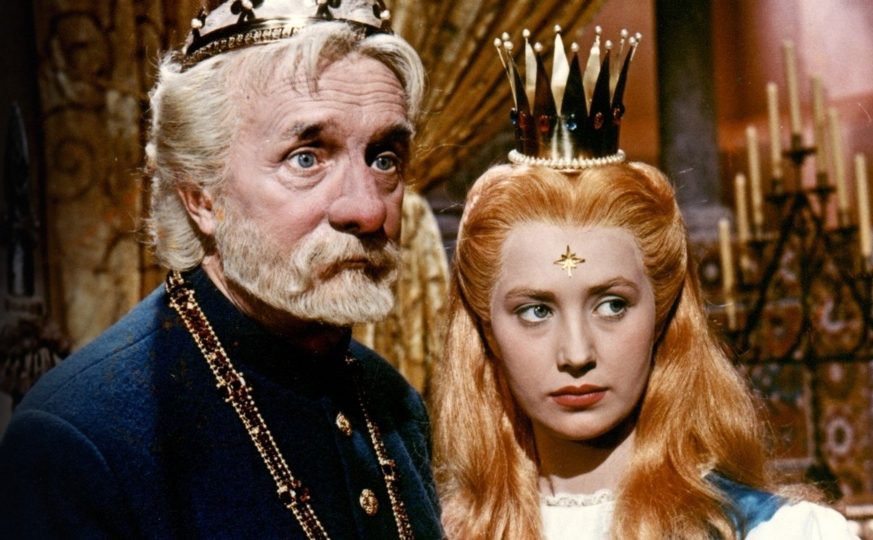In addition to several regime-conforming socialism-building and historical films he made after the 1948 Czechoslovak coup d’état, Martin Frič also filmed one of the most popular Czech fairy tales, The Princess with the Golden Star (Princezna se zlatou hvězdou, 1959). The first adaptation of a Slovak folk tale was written by Božena Němcová and published in 1846 in her book National Stories and Legends (Národní báchorky a pověsti).[1] More than a hundred years later, dramatist and filmmaker K. M. Walló adapted it into a rhymed theatre play for children.
The play premiered in the autumn of 1955 in the Jiří Wolker Theatre in Prague. It was this adaptation that served as a basis for a film script written by Walló himself in cooperation with Marin Frič in 1959. Thanks to the exceptional success of The Proud Princess (Pyšná princezna, 1952) both home and abroad seven years earlier, Czech fairy tale films could rely on increased production budgets. All fairy tales, including The Princess with a Golden Star, were shot exclusively on colour film stock.
Just like The Proud Princess, The Princess with the Golden Star wasn’t spared the process of ideologization. Together with the comedic tale Once Upon a Time, There Was a King (Byl jednou jeden král, 1954), it created a model which was used in Czech socialist fairy tales for decades. The poor prevail over the rich, the representatives of the upper class, such as kings, are comical figures, and the actions and beliefs of simple working class outweigh the actions and opinions of nobility.
The protagonist of the rhymed fairy tales with dance numbers and songs by Bohuslav Sedláček [2] is Lada (Marie Kyselková), a Princess with a golden star on her forehead. The young heroine flees her home in order to avoid her prospective husband, the unlikeable King Kazisvět (Martin Růžek) [3] and works as a cook in the neighbouring kingdom ruled by handsome and level-headed Prince Radovan (Josef Zíma). He sees through her mouse fur coat and recognizes a princess and also his chosen one.
Lada’s father, King Hostivít, as required by period ideological requirements, is a sitcom character. But he has another role in a fairy tale allegorically depicting the Second World War. The weak, compliant and rather feeble-minded ruler who yields his kingdom to Kazisvět without any resistance, represents the political representatives of pre-war Czechoslovakia, Beneš and Hácha, who, in the authors’ point of view, were also unable to resist the enemy (the symbol of Hostivít’s kingdom is a lion with a crown).
Kazisvět portrayed by Martin Růžek has traits of a militant German usurper (the symbols of his perfectly disciplined troops are reminiscent of Nazi insignia) or a Western imperialist in general. Kazisvět occupies Hostivít’s kingdom after unsuccessfully courting Lada. But eventually, he is driven out by the proletariat. Lada herself has a characteristically positive approach to work and spends her time gardening and embroidering. In Radovan’s kingdom, she works in the kitchen. There is no doubt that she understands the working class.
The final scenes of the film, when the people celebrate the victory over Kazisvět, erase the class differences and establish a communist society. Representatives of both kingdoms, servants and nobility meet at one table. The nanny even sits by Hostivít’s right hand.
But parallels can also be drawn with distant past, such as peasants’ revolts against the nobility and the defeat of Sigismund of Luxembourg by the Hussites whose legacy was frequently used by communist historiography (for instance Otakar Vávra’s Hussite trilogy). After all, Kazisvět has a similar ginger hair and haircut to Sigismund. It’s no coincidence that in the interpretation of the chief party historian Zdeněk Nejedlý, the monarch was associated to Fascism (as opposed to Žižka’s communism)
Radovan, on the other hand, is a prototype of a universally loved plebeian leader of a Soviet type (his favourite colour is red). Just like the Soviets defeated the Nazi Germany, the kind-hearted Radovan defeats the treacherous Kazisvět. One of the villain’s allies is, naturally, the Catholic Church, represented by a decrepit cleric, presumably a Jesuit.
In addition to studios, the fairy tale offering a forced interpretation of several crucial events of Czech and by extension also European history, was filmed at the Průhonice and Kokořín Castles. It was seen by more than 6 million cinemagoers and despite its biased interpretation of history, it still remains very popular. Perhaps thanks to the fact that it has gradually become an apolitical Christmas classic.
In 2023, Národní filmový archiv, Prague in collaboration with the Karlovy Vary IFF digitally restored the film in the Universal Production Partners and Soundsquare Studios in Prague.
The Princess with the Golden Star (Princezna se zlatou hvězdou, Czechoslovakia 1959), director: Martin Frič, script: K. M. Walló, Martin Frič, cinematography: Jan Roth, music: Bohuslav Sedláček, cast: František Smolík, Martin Růžek, Marie Kyselková, Josef Zíma, Jarmila Kurandová, Stanislav Neumann, Eduard Kohout, Josef Vinklář, Stella Májová et al. Barrandov Film Studios, 81 min.
Notes:
[1] The very first version was the fairy tale Prinzessin Mäusehaut written in 1810 by the Brothers Grimm.
[2] The lyrics of songs Pověz mi, modrá obloho and Prstýnek něžný dala mi were written by K. M. Walló. The first is performed by Marie Kyselková, the latter by Josef Zíma.
[3] In the original version by Božena Němcová, the princess doesn’t run away from a strange king, but from her stepfather who forces her into an arranged marriage.


